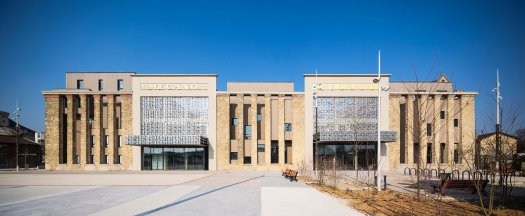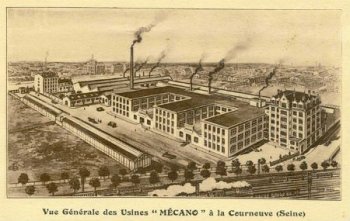
A former market-gardening town, La Courneuve became a major industrial center in the early 20th century. While the deindustrialization of the 1970s posed the essential problem of jobs, it was also accompanied by the industrial wastelands that dotted the town's landscape. The municipality, keen to preserve its working-class memory, commissioned the La Courneuve Ecomuseum to identify the most interesting industrial sites. Among those identified, Babcock, Johnson Factory and Mecano were included in the Land Use Plan as part of the remarkable local heritage.
The industrialization of Seine-Saint-Denis occurred in successive waves. The development of the railroads in northeastern Paris and the opening of the Aubervilliers-La Courneuve station in 1885 led to the establishment of heavy metallurgy in the area, particularly in La Courneuve. It was during this wave of industrialization that the Mécano factory was built in 1914. Mécano is a metallurgical plant specializing in precision tooling (taps, drills, milling cutters, reamers) and small machine tools.
A few years later, Johnson, Mecano's neighboring company, was taken over by Aciéries de Champagnole, which, among other activities, set up metal heat treatment and calibration workshops. At the same time, Mécano's managing director was Paul Faber, founder of Aciéries de Champagnole. Quite naturally, Mécano used its neighbor's steels to manufacture its American drill bits and precision tools. This proximity of raw materials to the production line enabled a significant reduction in costs and better inventory management.

General view of the Mecano La Courneuve plants
Situated along the railroad line - today's RER B line - the Mecano factory was built in several phases on a plot of over ten thousand square meters. Its style resembles the American "daylight factory" model (1), characterized by the construction of multi-storey workshops with open floors, illuminated by large glazed facades and terraced roofs. In this respect, its architecture is similar to that of its neighbor, the Johnson company. But by combining vernacular morphology with local materials, Mecano is a unique example in the département of the Americanization of regional industrial architecture. This American architectural model, which spread to Europe from 1860 onwards, opposes the model of single-storey halls, as in the case of the Babcock factory, by emphasizing the vertical organization of the production process. Alternating large vertical bays and pilasters in millstone, a material reminiscent of that used in the administration building, punctuate the rather plain facades of the workshops. The only decorative element is a white brick frieze. After the Second World War, the two single-storey workshops were raised and covered with sheds.
Generally speaking, the architecture of the office buildings is somewhat different from the rest, as they must reflect the company's image. They express the plant's pride and reliability. The Mecano office building in La Courneuve is a particularly outstanding example of this objective. The general appearance of Mecano's office building resembles that of a bourgeois apartment block. Constructed of millstone, the five-storey building is carefully decorated. Polychrome brickwork adorns the corners, window sills, central projection and pediments. The forebody, pierced by oeil-de-bœuf windows, houses the staircase. The building is topped by a mansard roof whose openings are crowned by polychrome brick pediments. The presence of these pediments is reminiscent of the mansard cornices on the nearby Town Hall, creating a kind of rivalry between the two styles.
Mecano employed 219 people in 1915, and nearly three times as many twenty years later. The 1974 takeover of the company by the De Wendel trust was to prove fatal for Mecano. Downsized by 30%, the metallurgical plant went from 738 employees to 540. Despite the support of local elected representatives, the "Mécanos struggle" came to an end in 1978 with the complete shutdown of the site. Abandoned, the site became part of the remarkable local heritage after the La Courneuve ecomuseum survey in 1983, and the municipality acquired the former Mecano office building. In keeping with the protective measures recommended by its new status, the building was rehabilitated and used as a garage and administrative annex to the town hall, and is now home to the La Courneuve media library.
Today, the Mecano factory is home to the Aimé Césaire or Mecano multimedia library.
(1) The "daylight factory" is the architectural style of the tower that was the very first to reach 10 storeys in downtown Montreal. The name, "daylight factory", derives from the system used to generously let in natural light through the opening of large bays integrated into the steel and concrete building. Le Corbusier himself used this principle, filling the frame entirely with bay windows.
On the same theme: visit a Parisian company in La Courneuve.